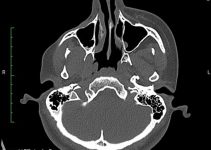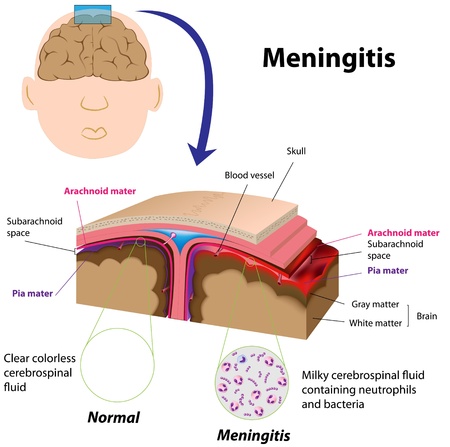Kernicterus is an acute condition that affects newborns, resulting in brain damage and even their death. Read and know what is Kernicterus as well as the causes, symptoms, diagnosis and treatment of this dreaded disorder.
Kernicterus Definition
Page Contents
- 1 Kernicterus Definition
- 2 Kernicterus Symptoms
- 3 Kernicterus Causes
- 4 Kernicterus Diagnosis
- 5 Kernicterus Differential Diagnosis
- 6 Kernicterus Treatment
- 7 Exchange transfusions
- 8 Kernicterus Risk factors
- 9 Kernicterus Prognosis
- 10 Kernicterus Complications
- 11 Kernicterus Prevention
- 12 Kernicterus and Cerebral Palsy
- 13 Does Kernicterus Go Away?
Medical researchers and doctors Kernicterus as a rare type of brain damage that arises in some newborns affected with acute cases of jaundice. The disorder usually affects the center of the brain in infants.
The condition is also known by the name Bilirubin Encephalopathy. The term “Kernicterus” stands for “yellow kern”, where “Kern” refers to the structures of the brain that are affected most frequently.
Kernicterus Symptoms
The symptoms of Kernicterus depend on the stage of the condition that a person is suffering from. The signs of the disorder in early, middle and late stage are mentioned below:
- Early Stage – This stage arises in the first few days of the life of infants. Patients already suffer from jaundice at this stage. They also display other difficulties such as lethargy and absent startle reflex. It is difficult to suck or feed such infants.
- Middle Stage – This phase varies in onset and duration. Sufferers cry out in a high-pitched voice and arch back with neck extremely extended backwards. They have a soft spot (bulging fontanel) and may suffer from seizures.
- Late Stage – This stage occurs in infants who are over a week in age. Affected newborns suffer from speech difficulties, high-frequency hearing loss, mental retardation and seizures. They may also display disorderly movement and muscular rigidity.
Kernicterus Causes
This condition is primarily a result of enhanced levels of unconjugated bilirubin. Bilirubin refers to a yellow pigment which is produced in the body when the old red blood cells are being recycled. High bilirubin levels in the human body can lead to a yellow appearance of the skin, giving rise to a condition called jaundice. In some cases, when there is an excess of bilirubin, the substance can get deposited in the brain tissue and give rise to acute neurological complications including hearing loss and brain damage. This is known as Kernicterus.
Kernicterus Diagnosis
The standard diagnosis of this condition involves a blood test, which helps detect a high level of Bilirubin (more than 20-25 mg/dL). This is preceded by a medical examination known as Jaundice Bilirubin Test that involves placing a light meter on the head of a sufferer. It helps measure Transcutaneous Bilirubin levels. Blood tests are recommended if Bilirubin levels are found to be high.
Kernicterus Differential Diagnosis
The differential diagnosis of this condition involves telling its symptoms apart from those of other similar disorders, such as:
- Herpes Simplex Virus (HSV) Infection
- Bacterial Meningitis
- Periventricular Leukomalacia
- Neonatal Sepsis
- Hyperammonemia
Kernicterus Treatment
The treatment of Kernicterus depends on the age (in hours) of the baby and whether any risks such as prematurity is associated with it. Treatment may involve:
Phototherapy
The procedure, also known as “Light therapy”, involves exposing infants to light. Exposure to light makes bilirubin undergo change in shape, making it become a non-toxic molecule that is soluble in water. Bilirubin is harmless in such a form and can easily be eliminated through defecation. In newborns, most cases of jaundice can easily be treated with Phototherapy.
Exchange transfusions
This medical process is used in rare cases where a newborn may not show a good response to Phototherapy and may still be susceptible to a Kernicterus brain damage. In this process, blood consisting of high bilirubin is substituted with fresh blood stored in banks. The process is executed at a very slow pace, over a course of several hours.
The process may also be used if an infant suffers from symptoms which suggest an already occurring Kernicterus brain damage. The problem can lead to the development of symptoms like changes in muscle tone, lethargy, arching of the back, high-pitched crying and difficulty in waking. If such symptoms occur, treatment must immediately begin to prevent any greater damage to the brain. Early treatment may sometimes help revert some of the damages that has already occurred.
Kernicterus Risk factors
Some infants stand at a greater risk of suffering from Kernicterus than others. They should closely be monitored more than others to prevent occurrence of the condition or to check it at the early stages. Such infants include those who
- Have a sibling who had jaundice
- Have bruises from birth
- Begin suffering from jaundice within a day of being born
- Are born prematurely
- Are difficult to feed
Infants having a Mediterranean or East-Asian origin or those having mothers with RH-negative factor or O blood types are also found to be more susceptible to this disorder. If jaundice is not timely treated in newborns, they can be extremely susceptible to this condition.
The presence of certain disorders increases the risk of having this condition. These diseases include:
- Crigler-Najjar syndrome
- Galactosaemia
- Hypothyroidism
- G6PD deficiency
Kernicterus Prognosis
This is an acute condition and its prognosis is guarded. Many infants suffering from neurological complications are found to die in the late stage.
This disease is found to occur in all parts of the world. However, it originates more frequently in areas where Glucose-6-phosphate dehydrogenase (G6PD) deficiency is found to be more common. There was a drop in the incidence of this disorder in the 1970s and 1980s followed by a rise in the 1990s. This rise has been associated to an early discharge of term babies but lack of follow-up care.
Kernicterus Complications
If left untreated, the condition may give rise to complications like
- Hearing loss
- Permanent brain damage
- Death
If the damage continues, patients may suffer from fever. Their heads may arch backwards into a much distorted position known as Retrocollis or Opisthotonus.
Kernicterus Prevention
This complication may be prevented by early diagnosis and cure of jaundice or disorders that lead to jaundice. According to “The American Academy of Pediatrics”, infants with the initial signs of jaundice should have their Bilirubin level measured within a day. In case of a high level, infants should be screened for conditions that require Hemolysis or the destruction of RBCs (red blood cells). The association also advocates a follow-up appointment for all newborns within 2 – 3 days after discharge from the hospital. This is mainly important for near-term or premature babies.
Kernicterus and Cerebral Palsy
If new mothers and their infants are discharged within 2 days or less, before jaundice attains its peak, cerebral palsy may occur. Cerebral palsy is a severe condition involving a deficiency or loss of motor control along with involuntary spasms. This results from congenital cases of permanent brain damage.
Does Kernicterus Go Away?
Recovery from this disorder depends on whether the condition is severe or mild. If treatment is carried out timely and manages to reduce the level of unconjugated bilirubin in the bloodstream, an infant can fully recover from jaundice as well as should go away Kernicterus.
If your baby is showing signs of this condition, immediately seek medical assistance. Timely diagnosis and treatment will go a long way in curing the condition and even turn back any damages that might already have occurred.
References:
http://www.patient.co.uk/doctor/Kernicterus.htm
http://www.medterms.com/script/main/art.asp?articlekey=4100
http://www.rightdiagnosis.com/k/kernicterus/intro.htm
http://www.ncbi.nlm.nih.gov/pubmedhealth/PMH0004562/


